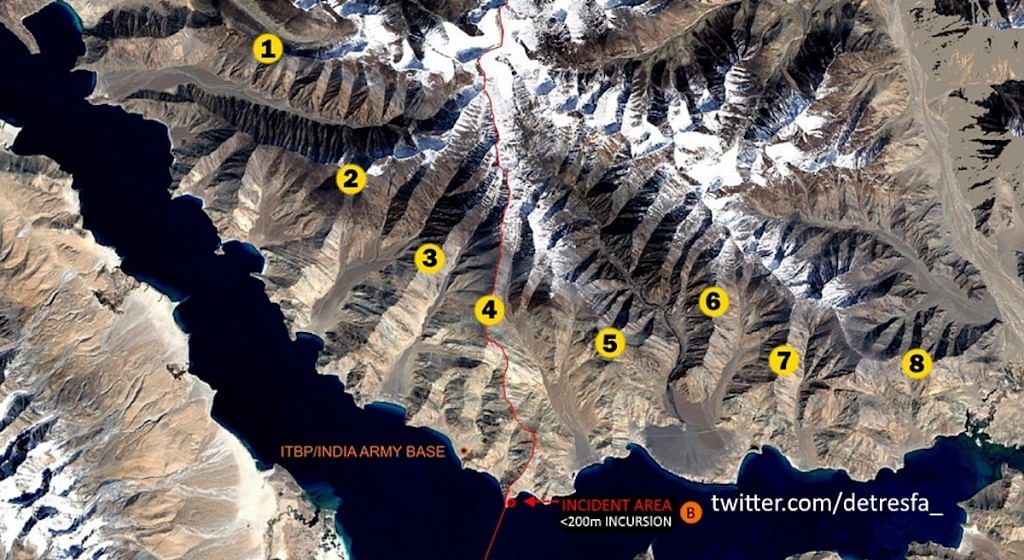New Delhi: India and China have initiated a disengagement process in the Galwan Valley, Hot Spring and Gogra Post area of Eastern Ladakh but there has not been any tangible movement in the Pangong Lake area, government sources said Monday.
However, the Army remained deeply cautious and said the de-escalation was still on and needs to be watched and followed up carefully.
“The disengagement plan, as was decided after three rounds of Corps Commander level talks, has been initiated,” a government source said.
Sources said the moving back of troops was happening in a gradual manner, in accordance with a timetable decided upon by the Corps Commanders.
Once the two sides pull back, the area in between will be considered a kind of buffer zone.
ThePrint Sunday reported that while there has been no de-escalation on the ground, a forward movement is expected this week.
According to the agreement reached between Corps Commanders, both Armies will have to withdraw by about 1.5-2 km from various spots.
“PLA (People’s Liberation Army) has been seen removing tents and other structures in the Galwan Valley. There are vehicles which are going back with the men and material,” a source said.
Asked specifically if there was movement from the Y-Junction in Galwan Valley where the 15 June clash had taken place, the source said, “Yes. There has been movement from there as well.”
The Y-junction is about 1.5 km inside the Indian territory from the Line of Actual Control (LAC).
Also read: India’s options against China shrink to two — limited war or another Wuhan
No tangible movement in Pangong, de-escalation verification
The sources said that there would be a verification process once the first round of de-escalation finishes.
As reported earlier, there will be a 72-hour window for both sides to verify the steps taken before initiating the next round of de-escalation.
“Rearward movement of vehicles of PLA seen at General Area of Galwan Hot Springs and Gogra. No specific distance can be said as of now. Confirmation only after verification,” a government source said.
When asked about the Pangong Lake area where the Chinese have occupied areas up to Finger 4, about 8 km inside the LAC which is at Finger 8, sources said there has “not been any tangible movement”.
Inputs say that the Chinese have removed some tents from the ridge lines near Finger 4 area.
The de-escalation comes at a time when the flow in the Galwan river has increased due to snow melting, according to inputs received, making it difficult for both India and China to sustain troop build up in the area.
Following the 6 June meeting between Corps Commanders, the PLA had not held up their end of the agreement, i.e., falling back by about 2 kilometres from the current position at Patrol Point 14, which led to the burning down of a Chinese tent in the Galwan Valley on 14 June and the subsequent clash in which 20 Indian soldiers were killed.
Also read: Military talks with the Chinese must not wear India down. Plan B should be ready
China will be closer to LAC than India in Galwan Valley
Both India and China had agreed to withdraw by about 1.5-2 km from the current areas where troop build-up had happened.
This means that China, which had crossed into the territory by about 1.5 km, will be closer to the LAC than India, which will have to move back further from across the Y-junction in Galwan Valley.
As reported by ThePrint on 26 June, the eventual game plan of Chinese incursions in the Galwan Valley seems to be to prevent India from carrying out any new construction beyond the confluence of the Shyok-Galwan river.
The Chinese also seek to restrict Indian patrols to the same point, located 4.5 km from the Line of Actual Control (LAC), rather than until Patrol Point 14, which is 500 metres from the border (according to the 1960 claim line of China) and marks the status quo before the PLA incursions began in May.
Also read: If you don’t shoot, you don’t escalate: NSAB chief explains how India, China have avoided war
